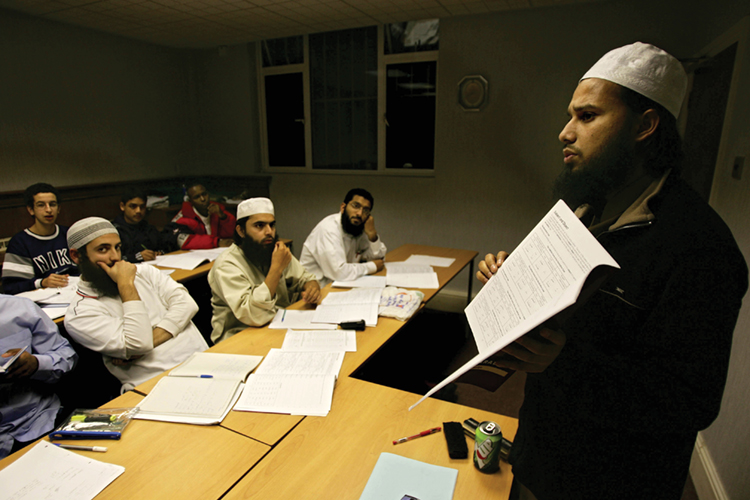Arabic is one of the world’s most widely used languages. It is the official language of many Arab nations in the Middle East and northern Africa. Nearly 300 million people use Arabic on a daily basis, and it is a major language in international business and politics. Arabic, a unique language that is read right to left, is also the language of the Qur`an, the sacred book of Islam. Last month, in December 2017, UNESCO—the United Nations (UN) Educational, Scientific and Cultural Organization—celebrated World Arabic Language Day. The annual celebration marks the UN’s adoption of Arabic as an official language on Dec. 18, 1973.
Arabic belongs to the Afro-Asian language family—that is, a group of languages descended from a common proto- or parent language. Other Afro-Asian languages include Amharic, used in Ethiopia; the Berber tongues of northern Africa; and the Hebrew language used by Jewish people throughout their history. Most of the people who speak Afro-Asian languages live in the Near East and in northern and northeastern Africa. Within the Afro-Asian family, Arabic is further categorized as a Semitic language. Semitic languages are some of the oldest in the world. Amharic, Arabic, Hebrew, and Tigre, spoken in Eritrea, are the principal spoken Semitic languages today. No one knows when Arabic originally developed, but people of the Arabian Peninsula were the first to use it. During the 600’s, Islam spread throughout southwestern Asia and northern Africa, and Arabic also spread to those areas.

The Arabic alphabet has 28 letters, only three of which are vowels. In writing, vowels may be included, left out, or indicated by symbols called diacritics. Arabic is written from right to left across a page, or—to people accustomed to languages written from left to right—from the back of a book to the front. There is no distinction between upper- and lower-case letters. The Arabic script features prominently in Islamic art as calligraphy. Simple words, such as Monday (?????????, or al-ithnayn), can be beautiful simply written on a page. Some modern artists, such as the French-Tunisian eL Seed, have combined Arabic calligraphy with graffiti to create artworks called calligrafitti.

Many other languages, including some outside the Afro-Asian family, have borrowed from Arabic. For example, English has many words that developed from Arabic. Such words include alcohol, algebra, checkmate, coffee, cotton, ghoul, lemon, magazine, racquet, and tariff. Some words were adopted and modified for use in another language, such as Spanish, then adopted and further modified in English.
People use different forms of Arabic in different contexts (circumstances or environments) and for different purposes. Native Arab speakers grow up speaking one of many local dialects (varieties). Across the Arab world, some of these dialects are so different that their speakers cannot understand one another. Classical Arabic is the language of the Qur`an, written down in the 600’s. Today, classical Arabic is more of a written language than a spoken one. It can be found, for example, in literature. Many Muslims learn classical Arabic in school and through study of the Qur`an. Modern Standard Arabic (MSA) is a modernized, simplified form of classical Arabic. Overall, it is similar to the classical form. MSA is used widely in broadcast and print media, motion pictures and television, modern literature, politics, mosques, and universities. People who speak different Arabic dialects may use MSA to communicate with one another.
Untitled Document
Can't view the linked articles? Subscribe to World Book Online

World Book Online delivers a progressive sequence of core databases supported by supplemental
tools, such as language translation, graphic organizers, and unique Webquests. Moving from
Early World of Learning to World Book Advanced, World Book Online aligns end-users with their
appropriate learning levels. Each stand-alone site provides additional features to support the
needs of users’ specific capabilities.
The World Book Difference
World Book combines cutting-edge technology with traditional editorial excellence to produce
authoritative, trustworthy, and unbiased content. The digital content is updated in real time and
carefully curated for each learning level. Accessible 24/7, the content is available on a variety of devices.
World Book Online combines 21st-century instructional techniques with timely information.
By breaking down complex topics and using easily understandable text, World Book Online helps to
build fluency and increase comprehension. Featuring single sign-on capability, these sites are paired
with highly visual content to engage even the most reluctant reader. Our collection of resources kindles
a lifelong learning experience for every user. This adherence to clarity, currency, and accuracy makes
World Book’s digital offerings an information hub for the classroom, library, and beyond.
Image 1: The official flag of the Arab League, an organization of Middle Eastern and African countries where Arabic is the main spoken language, is green with the emblem of the league in the center. The emblem features Arabic letters surrounded by a crescent, a yellow chain, and a white wreath. Credit: Flag Research Center
Image 2: The Arab world has both a political and a linguistic (language-related) definition. Politically, it includes many countries in the Middle East and across northern Africa. In a linguistic sense, the Arab world refers to those areas where most people speak Arabic as their native language. Credit: WORLD BOOK map
Image 3: Students learn Modern Standard Arabic (MSA) in a school in the United Kingdom. MSA is a modernized and simplified version of Arabic used to communicate across different dialects. Credit: © Getty Images